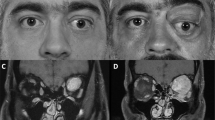Abstract
Aims
To evaluate presenting features of patients with orbital solitary fibrous tumours (SFTs), based on histological phenotype.
Methods
A retrospective case-note review was performed for demographics and presenting features for patients with orbital SFTs. The tumours were classified as “Group IA” hypocellular SFT phenotype, “Group IB” haemangiopericytoma phenotype and low mitotic activity, and high-grade “Group II” haemangiopericytoma phenotype with high mitotic activity.
Results
Sixty-four patients (34 female; 53%) presented at a mean age of 42.2 years (median 38; range 19–82), with Group II patients presenting at an older age (mean 53 years). Median symptom duration was 12 months for Groups IA and IB, compared to 4 months for Group II, the commonest symptoms being proptosis (53%), diplopia (41%), periorbital swelling (31%), and altered vision (19%). Mean LogMAR was 0.17 (median 0.0; range −0.2–4), and 14% had ipsilateral optic neuropathy, with no significant difference between the three groups. Non-axial displacement was noted in 69%, a palpable mass in 45%, and reduced eye movements in 59%; choroidal folds and optic disc swelling were recorded in 12% and 9%. SFTs were mostly extraconal (59%), within the superior and superonasal quadrants (44%), with an average estimated tumour volume of 4.9 ml (median 3.6; range 0.31–14.5 ml).
Conclusion
SFTs may present with impaired visual function (∼15%), fundal abnormalities (a fifth), globe displacement (two-thirds), and reduced ocular motility (over a half). High-grade tumours tend to present more than a decade later, with a shorter duration of symptoms.
This is a preview of subscription content, access via your institution
Access options
Subscribe to this journal
Receive 18 print issues and online access
$259.00 per year
only $14.39 per issue
Buy this article
- Purchase on Springer Link
- Instant access to full article PDF
Prices may be subject to local taxes which are calculated during checkout


Similar content being viewed by others
Data availability
The basic data set for this investigation is not available in the public domain.
References
Demmico EG, Fritchie KJ, Han A. Solitary fibrous tumours. In: The WHO Classification of Tumours Editorial Board, editor. WHO classification of tumours of soft-tissue and bone. 5th ed. Lyon, France: IARC; 2020. p. 104-8.
Giannini C, Rushing EJ, Hainfellner JA, Bouvier C, Figarella-Branger D, von Deimling A, et al. Solitary fibrous tumour/Haemangiopericytoma. In: Louis DN, Ohgaki H, Wiestler OD, Cavenee WK, Ellison DW, Figarella‐Branger D, et al. editors. WHO classification of tumours of the central nervous system. 4th ed. Lyon, France: IARC; 2016. p. 249–54.
René C, Scollo P, O’Donovan D. A review of solitary fibrous tumours of the orbit and ocular adnexa. Eye. 2022. https://doi.org/10.1038/s41433-022-02160-w.
Furusato E, Valenzuela IA, Fanburg-Smith JC, Auerbach A, Furusato B, Cameron JD, et al. Orbital solitary fibrous tumour: encompassing terminology for haemangiopericytoma, giant cell angiofibroma, and fibrous histiocytoma of the orbit: reappraisal of 41 cases. Hum Pathol. 2011;42:120–8.
Thompson LDR, Liou SS, Feldman KA. Orbit solitary fibrous tumour: a proposed risk prediction model based on a case series and comprehensive literature review. Head Neck Pathol. 2021;15:138–52.
Bonavolontà G, Strianese D, Grassi P, Comune C, Tranfa F, Uccello G, et al. An analysis of 2,480 space-occupying lesions of the orbit from 1976 to 2011. Ophthalmic Plast Reconstr Surg. 2013;29:79–86.
Goto H, Yamakawa N, Komatsu H, Asakage M, Tsubota K, Ueda S-I, et al. Clinico-epidemiological analysis of 1000 cases of orbital tumours. Jpn J Ophthalmol. 2021;65:704–23.
Blessing NW, Bermudez-Magner JA, Fernandez MP, Rosenberg AE, Dubovy SR, Johnson TE. Solitary fibrous tumour of the orbit: a case series with clinicopathologic correlation and evaluation of STAT6 as a diagnostic marker. Ophthalmic Plast Reconstr Surg. 2020;36:164–71.
Croxatto JO, Font RL. Haemangiopericytoma of the orbit: a clinicopathologic study of 30 cases. Hum Pathol. 1982;13:210–8.
Sullivan TJ, Wright JE, Wulc AE, Garner A, Moseley I, Sathananthan N. Haemangiopericytoma of the orbit. Aust N Z J Ophthalmol. 1992;20:325–32.
Bonaffini SG, Patel S, Zhou J, Carrasco J. Solitary fibrous tumour of the caruncle: a solitary location. Orbit. 2020;41:250–2.
Vahdani K, Gupta T, Verity DH, Rose GE. Extension of masses involving the lacrimal sac to above the medial canthal tendon. Ophthalmic Plast Reconstr Surg. 2021;37:556–9.
Zeitler D, Kanowitz S, Har-El G. Malignant solitary fibrous tumour of the nasal cavity. Skull Base. 2007;17:239–46.
Ahn JY, Shim JY, Yang WI, Kim TS. Meningeal solitary fibrous tumour as an unusual cause of exophthalmos: case report and review of the literature. Neurosurgery. 2001;48:1362–6.
Patel MM, Jakobiec FA, Zakka FR, Du R, Annino DJ, Borboli-Gerogiannis S, et al. Intraorbital metastasis from solitary fibrous tumour. Ophthalmic Plast Reconstr Surg. 2013;29:e76–9.
Rose AM, Kabiru J, Rose GE. A rare case of orbital haemangiopericytoma arising in childhood. Orbit. 2013;32:384–6.
Arshad AR, Normala B. Infantile malignant haemangiopericytoma of the orbit. Ophthalmic Plast Reconstr Surg. 2008;24:147–8.
Boyle J, Kennedy C, Berry J, Mott MG. Congenital haemangiopericytoma. J R Soc Med. 1985;78:10–12.
Yang BT, Wang YZ, Dong JY, et al. MRI study of solitary fibrous tumour in the orbit. Am J Roentgenol. 2012;199:W506–11.
Alkatan HM, Alsalamah AK, Almizel A, et al. Orbital solitary fibrous tumours: a multi-centered histopathological and immunohistochemical analysis with radiological description. Ann Saudi Med. 2020;40:227–33.
Smith SC, Gooding WE, Elkins M, et al. Solitary fibrous tumours of the head and neck. Am J Surg Pathol. 2017;41:1642–56.
Author information
Authors and Affiliations
Contributions
GER initiated the work and both authors contributed to data acquisition and writing.
Corresponding author
Ethics declarations
Competing interests
The authors declare no competing interests.
Additional information
Publisher’s note Springer Nature remains neutral with regard to jurisdictional claims in published maps and institutional affiliations.
Rights and permissions
About this article
Cite this article
Vahdani, K., Rose, G.E. Presentation of orbital solitary fibrous tumours. Eye 37, 3406–3411 (2023). https://doi.org/10.1038/s41433-023-02519-7
Received:
Revised:
Accepted:
Published:
Issue Date:
DOI: https://doi.org/10.1038/s41433-023-02519-7



